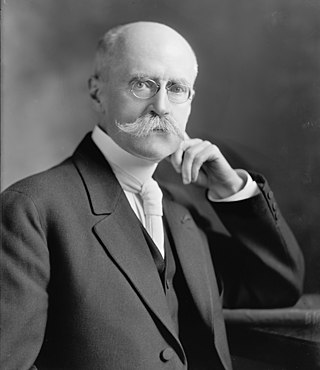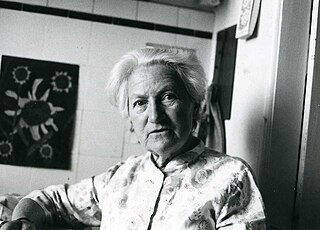
A mural is any piece of graphic artwork that is painted or applied directly to a wall, ceiling or other permanent substrate. Mural techniques include fresco, mosaic, graffiti and marouflage.

Diego Rivera was a prominent Mexican painter. His large frescoes helped establish the mural movement in Mexican and international art.

Edwin Howland Blashfield was an American painter and muralist, most known for painting the murals on the dome of the Library of Congress Main Reading Room in Washington, DC.

The Charles H. Wright Museum of African American History is a museum of African-American history and culture, located in Detroit, Michigan. Located in the city's Midtown Cultural Center, The Wright is one of the world's oldest and largest independent African-American museums, holding the world's largest permanent collection of African-American culture. With a collection of more than 35,000 artifacts, The Wright's current 125,000-square-foot museum opened as the largest museum in the world dedicated to African-American history.

Julius Garibaldi Melchers was an American artist. He was one of the leading American proponents of naturalism. He won a 1932 Gold medal from the American Academy of Arts and Letters.
Charles Cecil Pollock was an American abstract painter and the eldest brother of artist Jackson Pollock.

Lucienne Bloch was a Switzerland-born American artist. She was best known for her murals and for her association with the Mexican artist Diego Rivera, for whom she produced the only existing photographs of Rivera's mural Man at the Crossroads, painted in 1933 and destroyed in January 1934 at Rockefeller Center in New York City.
Steve "Pablo" Davis was an American artist, lifelong communist activist and Detroit community organizer. He was the last living member of the team of artists who worked with Diego Rivera on the Detroit Industry mural which is in the central courtyard, Rivera Court, of the Detroit Institute of Arts.

Lucia Wiley was a noted New Deal muralist and painter born and raised in Tillamook, Oregon. Lucia Wiley was the oldest of six children and always found herself interested in art, even at a young age. In 1923 Wiley stated, "He who has an art has every where a part," in her high school yearbook. In 1924 Wiley started college at the University of Minnesota where she pursued a degree in fine arts. In 1928 she transferred to the University of Oregon to further her studies and in 1930, she received a Bachelor of Arts degree majoring in fine arts. Lucia went on to further her schooling and graduated with a Masters in Fine Arts from the University of Oregon.

Charles McGee was an American artist and educator known for creating paintings, assemblages, and sculptures. His artwork is in the collections of the Detroit Institute of Arts and the Charles H. Wright Museum of African American History. He also had several large-scale public works in the city of Detroit.

The Detroit Industry Murals (1932–1933) are a series of frescoes by the Mexican artist Diego Rivera, consisting of twenty-seven panels depicting industry at the Ford Motor Company and in Detroit. Together they surround the interior Rivera Court in the Detroit Institute of Arts. Painted between 1932 and 1933, they were considered by Rivera to be his most successful work. On April 23, 2014, the Detroit Industry Murals were designated by the Department of Interior as a National Historic Landmark.

Hugo Ballin was an American artist, muralist, author, and film director. Ballin was a member of the National Institute of Arts and Letters and the National Academy of Design.

The Treasury Section of Painting and Sculpture was a New Deal art project established on October 16, 1934, and administered by the Procurement Division of the United States Department of the Treasury.

Mexican muralism refers to the art project initially funded by the Mexican government in the immediate wake of the Mexican Revolution (1910–1920) to depict visions of Mexico's past, present, and future, transforming the walls of many public buildings into didactic scenes designed to reshape Mexicans' understanding of the nation's history. The murals, large artworks painted onto the walls themselves had social, political, and historical messages. Beginning in the 1920s, the muralist project was headed by a group of artists known as "The Big Three" or "The Three Greats". This group was composed of Diego Rivera, José Clemente Orozco and David Alfaro Siqueiros. Although not as prominent as the Big Three, women also created murals in Mexico. From the 1920s to the 1970s, murals with nationalistic, social and political messages were created in many public settings such as chapels, schools, government buildings, and much more. The popularity of the Mexican muralist project started a tradition which continues to this day in Mexico; a tradition that has had a significant impact in other parts of the Americas, including the United States, where it served as inspiration for the Chicano art movement.

Paul Kelpe was a German-born American abstract painter. His constructions integrating found objects into paintings were the first such works created in the United States and he painted two of the five Williamsburg murals, the first abstract murals in the United States. In addition to his mural work for various American government projects, he was an innovative independent painter and university art professor. He was a pioneer of American abstract art, including his work in Chicago during a period in which abstracts were not well accepted or appreciated.

Bernard Baruch Zakheim was a Warsaw-born San Francisco muralist, best known for his work on the Coit Tower murals.
Gilda Snowden was an African-American artist, educator and mentor from Detroit, Michigan.

Roy Charles Gamble was an American impressionist painter, muralist, and portraitist born in Detroit, Michigan.
Shirley Woodson is an American visual artist, educator, mentor, and art collector who is most known for her spectacular figurative paintings depicting African American history. Her work that spans a career of 60 years and counting can be found in the collections of the Detroit Institute of Arts, the Charles H. Wright Museum of African American History, and the Studio Museum in Harlem, among other institutions. Woodson was named the 2021 Kresge Eminent Artist. The Detroit Institute of Arts exhibited 11 of her pieces in "Shirley Woodson: Shield of the Nile" Dec. 18, 2021 through June 12, 2022, the museum's first solo exhibition of Woodson's work. A painting by Woodson is featured in the Museum of Contemporary Art Detroit exhibition "Ground Up: Reflections on Black Abstraction" April 8-August 16, 2022.

Ryah Ludins (1896–1957) was a Ukrainian-born American muralist, painter, printmaker, art teacher, and writer. She made murals for post offices and other government buildings during the Great Depression and also obtained commissions for murals from Mexican authorities and an industrial concern. Unusually versatile in her technique, she made murals in fresco, mixed media, and wood relief, as well as on canvas and dry plaster. She exhibited her paintings widely but became better known as a printmaker after prints such as "Cassis" (1928) and "Bombing" drew favorable notice from critics. She taught art in academic settings and privately, wrote and illustrated a children's book, and contributed an article to a radical left-wing art magazine. A career spanning more than three decades ended when she succumbed to a long illness in the late 1950s.
















